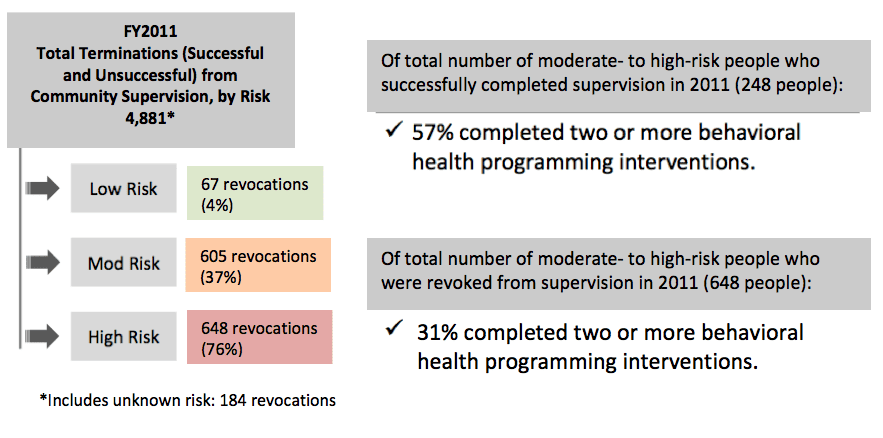Turning Policy into Practice: One State’s Approach to Providing Behavioral Health Treatment for People on Supervision in the Community
After years of pursuing separate approaches to providing supervision and treatment, Kansas has become a national leader in providing integrated services to people on probation and parole who need mental health or substance use treatment. Previously, probation and parole officers responded to relapse with a disciplinary approach that was focused on abstinence rather than recovery and treatment. Such an approach contributed to the significant increase in the number of individuals with mental health or substance use disorders returning to prison from community supervision. As part of its justice reinvestment approach to reducing recidivism and protecting public safety, Kansas has improved supervision practices and invested millions of dollars in behavioral health treatment services, including hiring new staff to provide those services, and training corrections and behavioral health providers.
The Kansas Approach to Integrated Care
Early in 2015, more than 150 supervision officers, mental health and substance use treatment providers, and case managers—many of whom were hired as a result of justice reinvestment—gathered in Sedgwick and Johnson Counties in Kansas to participate in the state’s first-ever behavioral health cross-training effort. The all-day training—which was hosted by the Kansas Department of Corrections (KDOC) and funded by the U.S. Department of Justice’s Bureau of Justice Assistance—brought together teams of staff from local jurisdictions in these two counties, which have the largest concentrations of people on supervision in the state, with the aim of educating and engaging practitioners who work with people who are involved with the criminal justice system.
The event provided not only a learning opportunity but also a platform for individuals to share their experiences delivering behavioral health services and addressing barriers to client success in Kansas. Panelist Deborah Shaffer, a clinician working with Sedgwick County’s largest behavioral health service provider, COMCARE, in conjunction with the Sedgwick County Department of Community Corrections, explained, “Many of the clients that come to us have failed again and again in the community after trying a number of ‘cookie cutter’ treatment modalities. They feel hopeless and ashamed.”
From 2012 to 2013, The Council of State Governments (CSG) Justice Center worked with Kansas state leaders to develop data-driven policy options designed to reduce corrections spending and increase public safety. In preparing its analysis, the CSG Justice Center identified a correlation between access to treatment services in the community and client success on community supervision. Of those moderate- and high-risk people who successfully completed probation in Kansas in FY2011, a majority (57 percent) had received two or more behavioral health programming interventions. Of people whose probation was revoked, just one-third (31 percent) had received such behavioral health interventions.
The Kansas State Legislature appropriated $2 million in FY2014 and $3 million in FY2015 to increase KDOC’s capacity to provide quality treatment and supervision to people on probation and parole who have behavioral health treatment needs. This funding was allocated as a result of the state’s 2013 justice reinvestment effort (House Bill 2170), and supports the work of 57 personnel across the state who are largely embedded in county-level community corrections agencies and affiliated with local service providers. These treatment professionals, including Deborah Shaffer, now perform a wide range of services, such as conducting clinical assessments of people who are involved with the criminal justice system, managing crisis situations, partnering with supervision officers to refer individuals to appropriate treatment, and leveraging local resources to ensure that individuals are receiving timely services based on their specific behavioral health needs.
Shaffer explained, “Our clients are typically struggling to get their basic needs met. Many of them have experienced trauma, domestic violence, abuse; in many cases the individuals in their support system may also have a history of substance use and mental illness. This funding has allowed us to think creatively about treatment and to implement new initiatives that work.”
Figure I. Outcomes for People on Community Supervision, FY2011
Since the funding was initially allocated in October 2013, more than 1,000 clients have been referred to justice reinvestment-funded treatment services in Kansas.
This funding has meant that service recipients have more timely access to better quality behavioral health resources, including in-patient and outpatient treatment, medications, and individualized therapy. Moreover, clients receiving services have reported more positive attitudes toward their supervising officer, whom they now identify as an ally on the road to recovery rather than a barrier to success, as they might have under the previous, more disciplinary approach to supervision.
KDOC has also made peer support and mentorship resources available for clients: peer support specialists attend to people with mental health issues, whereas recovery coaches assist those with substance use problems. These professionals serve as a “stopgap” for instances when clients may be waitlisted for treatment, need help navigating the complex provider network, or have difficulty remaining engaged in programming. The specialists and coaches have, themselves, overcome problematic substance use or battled mental disorders, and they work to promote hope, motivation, and dedication in their clients, and to prevent relapse during the recovery process.
Annie Neri, a peer mentor from Johnson County, has experienced both sides of Kansas’ state health system. Having once been a client herself, she is now a service provider who recognizes many of the benefits this initiative has yielded for supervision officers, service providers, and clients alike.
“When our team started helping clients coordinate the various aspects of their lives, we saw an amazing difference,” Annie said. “I know that the services we provide as part of this grant program are actually making an impact, and once officers saw what this was doing for their caseloads, the referrals started pouring in.”
As a result of the work of Annie and others hired through the justice reinvestment funds, probation officers in Kansas now have more time to dedicate to the oversight of the moderate- and high-risk individuals on their caseload. The public safety implications of this targeted supervision are significant, particularly in urban centers such as Olathe (Johnson County) and Wichita (Sedgwick County), where approximately 45 percent of the people involved with the criminal justice system are highly likely to reoffend if they are not being intensively supervised and receiving quality treatment to address ongoing needs.
Ray Roberts, Secretary of the Kansas Department of Correction, attributes these positive outcomes to the state’s investment in evidence-based behavioral health services. “When corrections workers and behavioral health care providers collaborate for an integrated approach to supervision and treatment, offenders are more successful. Through this initiative, more offenders are succeeding out of the system, and becoming stable, law-abiding citizens. When this happens, prison beds can be reserved for more dangerous individuals, and communities across the state become safer.”
This project was supported by Grant No. 2013- ZB-BX-K002 awarded by the Bureau of Justice Assistance. The Bureau of Justice Assistance is a component of the Department of Justice’s Office of Justice Programs, which also includes the Bureau of Justice Statistics, the National Institute of Justice, the Office of Juvenile Justice and Delinquency Prevention, the Office for Victims of Crime, and the SMART Office. Points of view or opinions in this document are those of the author and do not necessarily represent the official position or policies of the U.S. Department of Justice.
The sharp rise in school shootings over the past 25 years has led school officials across the U.S.…
Read MoreA three-digit crisis line, 988, launched two years ago to supplement—not necessarily replace—911. Calling 988 simplifies access to…
Read More Taking the HEAT Out of Campus Crises: A Proactive Approach to College Safety
Taking the HEAT Out of Campus Crises: A Proactive Approach to College Safety
The sharp rise in school shootings over the past 25 years has…
Read More From 911 to 988: Salt Lake City’s Innovative Dispatch Diversion Program Gives More Crisis Options
From 911 to 988: Salt Lake City’s Innovative Dispatch Diversion Program Gives More Crisis Options
A three-digit crisis line, 988, launched two years ago to supplement—not necessarily…
Read More Matching Care to Need: 5 Facts on How to Improve Behavioral Health Crisis Response
Matching Care to Need: 5 Facts on How to Improve Behavioral Health Crisis Response
It would hardly be controversial to expect an ambulance to arrive if…
Read More Explainer: Key Findings and Options from Arkansas’s Justice Reinvestment Initiative
Explainer: Key Findings and Options from Arkansas’s Justice Reinvestment Initiative
Arkansas policymakers have long expressed concerns about the state’s high recidivism rate.…
Read More Explainer: How a New Law in Arkansas Tackles Crime, Recidivism, and Community Supervision Challenges
Explainer: How a New Law in Arkansas Tackles Crime, Recidivism, and Community Supervision Challenges
In April 2025, Arkansas Governor Sarah Huckabee Sanders signed a package of…
Read More











